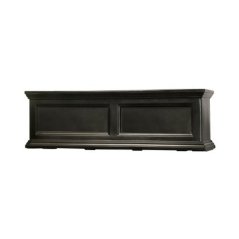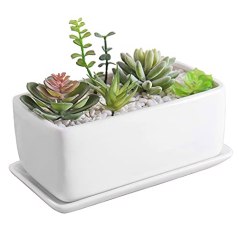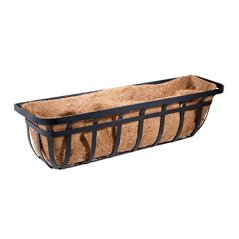BestReviews is reader-supported and may earn an affiliate commission. Details

An excellent buy if you want a product that looks a little different from your average window box.
Made from stainless steel with an attractive "antique" finish. Durable and well-made; users are extremely pleased with its quality. Comes with matching drip tray.
May be difficult to wall-mount due to its shape.

A large, sturdy window box that comes at a bargain price.
An excellent choice and great quality, this window box is durable and frost-resistant. Users report their boxes don't fade, even when exposed to daily sun.
If you want to wall-mount it below your window ledge, you'll have to buy brackets separately.

A well-crafted, highly durable window box made from weatherproof, UV-resistant molded plastic.
We love the double-walled design, which creates a water reservoir to keep plants hydrated. Easy to install with included wall mount brackets.
Users must drill a hole in the planter to fill the water reservoir.

This stylish ceramic model is designed for use with succulents or small plants, such as culinary herbs.
A decent size, but not too huge. Plenty of drainage; comes with matching saucer to catch excess water. Users are pleased with its excellent quality.
No way to wall-mount it, so only suitable as an indoor window box, unless you have a wide outdoor ledge it can sit on.

A well-made, versatile planter with a classic rustic appearance. Made from steel with a powder black finish for a cast iron look.
Affordable price and good quality. Coco fiber liner drains well and is easily replaceable when it wears out. At 30 inches long, it fits plenty of plants.
Some users complain about the mounting hardware, but you can buy brackets separately if you don't like those included.

We recommend these products based on an intensive research process that's designed to cut through the noise and find the top products in this space. Guided by experts, we spend hours looking into the factors that matter, to bring you these selections.

Just like a piece of jewelry that adds the finishing touch to an outfit, a window box overflowing with colorful blooms adds the finishing touch to your home’s exterior. Of course, window box planters aren’t limited to decorating windows. In fact, their shape makes them highly suited to many areas around your home, including mounting on fences, lining the railing around a deck, adding a touch of color to a front entry, or jazzing up a patio. You can even mount a window box indoors, an especially nice option for a sunny window in an upper-level apartment.
That said, many beginning gardeners find the wide variety of choices at their local nursery to be a bit intimidating, as window boxes come in a range of sizes, styles, and materials. Then there’s the big question: what are the best flowers and foliage to plant in a window box?

One of the biggest choices you’ll need to make when choosing a window box is the material. There are quite a few commonly used materials, each with their own pros and cons.
This is the classic orange clay pot you probably visualize when picturing a planter. Terracotta looks good with just about any landscape or architectural theme and works well with just about any kind of plant. Look for plain terracotta window boxes to complement a modern home and embossed or textured terracotta window boxes for more rustic, farmhouse-style homes. Because terracotta can be heavy, especially when wet, you’ll need to mount a clay window box on very sturdy brackets.
Pros:
Cons:
Wood window boxes range from elegant teak to rustic knotty pine, although cedar and redwood are two of the most popular woods for planters. Wood window boxes have a classic look that suits almost any architectural style, but they are particularly suited to country, Mediterranean, or ranch homes. Because wood is heavy, most of these window boxes are mounted on brackets.
Pros:
Cons:
Metal window boxes typically have an inner liner, which is often made of coconut fiber. Quite a few different metals are used for these planters, including copper, aluminum, galvanized steel, and wrought iron. You’ll find metal window boxes in a wide range of styles, including sleek and streamlined, rustic and weathered, Mediterranean-inspired, and traditional country cottage. Typically, you can either nail a metal window box directly to your home’s exterior or mount it on a bracket.
Pros:
Cons:
Plastic window boxes come in a wide range of colors, styles, and sizes. You can find plastic planters designed to resemble other materials and in styles to complement any landscape theme. The least expensive plastic window boxes are usually vinyl, but for sturdier, longer-lasting planters, PVC is a better choice. You can generally nail plastic window boxes directly to your home’s exterior.
Pros:
Cons:
Fiberglass window boxes combine many of the best features of other common materials. These planters come in a wide range of colors or are patterned to resemble other materials, including wood, stone, clay, and metal. Fiberglass is resistant to all types of weather, including high heat, rain, and freezing conditions, and it won’t rot, crack, or warp. Hang your fiberglass window box on brackets.
Pros:
Cons:

It’s important to choose a window box that’s the right size for your window. Otherwise, you’ll get an imbalanced look. As a general rule, a window box should stretch the entire length of the window. If the window has shutters, go a few inches wider so the planter extends past the shutters on each side. Window boxes are available in a wide range of standard sizes, from 18 inches up to six feet in length.
When it comes to the height of your window box, eight inches is the minimum to support healthy plant growth, but 12 inches is better and makes a bigger splash against larger windows. Typically, a window box will measure the same depth as it does in height.
There are window boxes to match just about any landscaping or architectural style. Traditional window boxes without an excess of frills or embellishments work with any architectural design. For a modern home, consider a metal or fiberglass window box with straight lines and an upright shape. Hayrack or embellished wrought iron window boxes complement farmhouse-style homes, as do wooden planters. Liven up your Mediterranean-inspired architecture with a wrought iron or wood window box. Of course, ultimately, the right window box for your home is the one you like best, so most importantly, consider your personal preferences.
There are four main methods for mounting your window box beneath the window: direct mount, wall brackets, cleat mount, and railing brackets.
Some lightweight plastic or wood window boxes have predrilled holes, so you can screw them directly to the exterior wall of your house. Metal cage or hayrack window boxes also typically screw into the wall.
Heavier window boxes require L-brackets for sturdy support. These brackets are bolted to the wall and have legs to support the window box. Generally, the brackets are metal or wood, and styles range from very plain to quite ornate. Window boxes that are three feet or longer should have three brackets for extra support, but two brackets are sufficient for shorter planters.
Mostly used for wood or fiberglass window boxes, cleat mounts have a wooden cleat that screws to the wall and fits into a corresponding groove in the back of the window box.
If you are attaching your window box to a fence, deck railing, or balcony railing, you’ll need railing brackets. These usually screw to the fence or railing, but some are designed to hold in place without screws.
Metal cage window boxes always require a liner to hold dirt and plants in place. Coconut fiber liners are the most popular, but there are also plastic liners if you prefer something less rustic. Plastic liners can also be used in wood or terracotta window boxes to help cut down on rot or damage from moisture and plant roots.
Many window boxes have a self-watering feature, cutting down on the work required to keep your plants healthy. Typically, a self-watering window box has a reservoir at the bottom for water. A small pop-up indicator lets you know when the reservoir is empty. Refilling the reservoir is easy. Just pour water into the access tube tucked into a corner of the planter.
Because there are so many types and sizes of window boxes, the price range is quite wide.
Under $50, you’ll find plastic window boxes, less desirable types of wood window boxes, and metal window boxes that are no more than two feet long.
Between $50 and $100 is the sweet spot for most window boxes. In this range, you’ll find many sizes and most materials, including cedar and redwood, PVC, fiberglass, and most metals.
Over $100, you’ll find extra-long window boxes, boxes made of pricier materials such as copper, ornate designs, and the best quality.


Q. How should I care for my planted window boxes?
A. Unless it’s a self-watering planter, your window box will have drainage holes. Fill it with potting soil, not topsoil or garden soil. Check the soil daily when the weather is warm or windy as window boxes dry out quickly. Water regularly and add fertilizer several times throughout the growing season to keep your flowers coming. Treat pests as necessary and remove spent flowers to encourage repeat blooms.
Q. What are the best flowers for a window box?
A. The best flowers are the ones you like best, and that are suited to the sun exposure the window box receives, but there are certainly some varieties of flowers that do better in window boxes than others. Some especially good choices include: petunias, verbena, ivy geraniums, alyssum, begonias, nasturtiums, angelonia, calibrachoa, phlox, ranunculus, tulips, and bacopa.
Q. Can I use my window boxes to grow vegetables?
A. Although most gardeners use their window boxes to show off flowers, there are certainly other choices. While tall or large vegetables aren’t options, you can grow smaller vegetables like lettuce, herbs, spinach, beets, dwarf varieties of peppers, and short varieties of carrots or onions successfully in a sunny window box. You can even grow tomatoes, as long as you choose a dwarf variety that’s bred for successful growth in a storage container.
Get emails you’ll love.
Learn about the products you’re wondering if you should buy and get advice on using your latest purchases.
